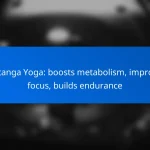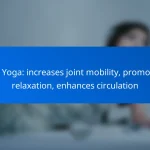Vinyasa Yoga is a dynamic practice that seamlessly links movement and breath, making it an excellent choice for enhancing physical fitness and overall well-being. Suitable for practitioners of all levels, this adaptable style allows beginners to gradually build strength and flexibility while enjoying the mental benefits of mindfulness. Whether in a class or through online resources, Vinyasa Yoga offers a welcoming environment for everyone to explore their practice.
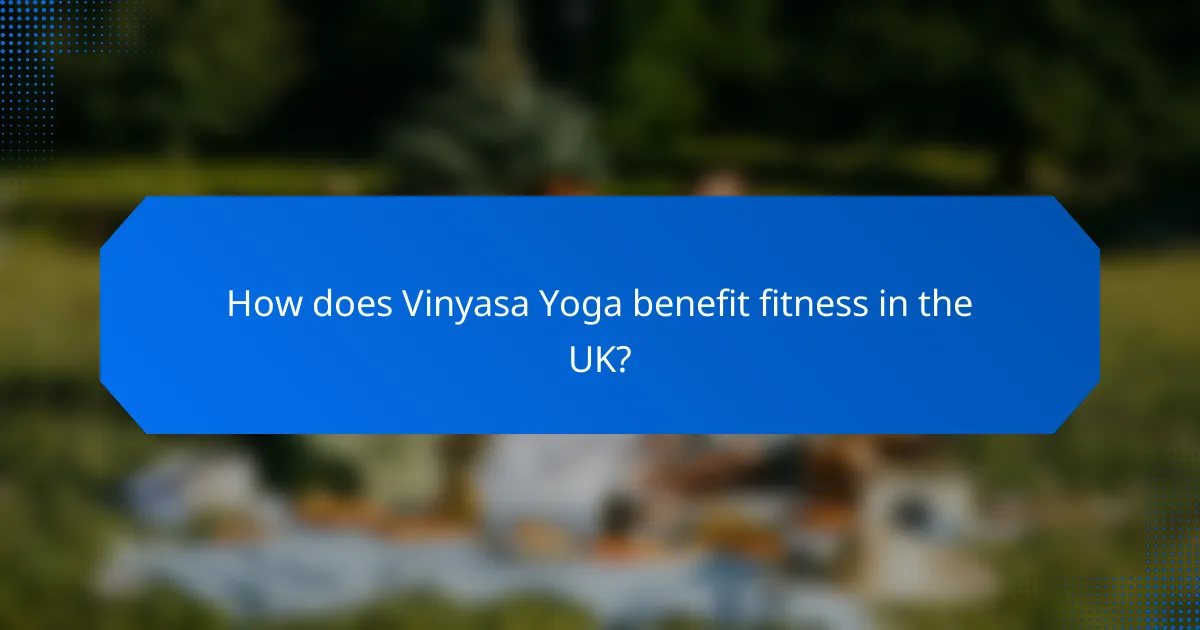
How does Vinyasa Yoga benefit fitness in the UK?
Vinyasa Yoga offers numerous fitness benefits in the UK, making it suitable for practitioners of all levels. Its dynamic flow not only enhances physical fitness but also promotes overall well-being through a combination of movement and breath.
Improves cardiovascular health
Vinyasa Yoga can significantly improve cardiovascular health by increasing heart rate during practice. The continuous flow of poses encourages better circulation and can help lower blood pressure over time.
For optimal cardiovascular benefits, aim for sessions that last at least 30 minutes, focusing on maintaining a steady pace. Regular practice can lead to improved endurance and heart efficiency.
Enhances flexibility and strength
This style of yoga is effective for enhancing both flexibility and strength. The variety of poses stretches different muscle groups while also building muscle tone, particularly in the core, arms, and legs.
Incorporating poses like Downward Dog and Warrior II can help increase flexibility in the hips and shoulders. Practicing consistently, ideally 2-3 times a week, will yield noticeable improvements in both areas.
Promotes weight loss
Vinyasa Yoga can aid in weight loss by burning calories through its energetic sequences. Depending on the intensity, a typical session may burn anywhere from 300 to 600 calories.
To maximize weight loss benefits, combine Vinyasa sessions with a balanced diet and other forms of exercise. Staying mindful of portion sizes and nutritional choices can enhance results.
Boosts mental well-being
Practicing Vinyasa Yoga not only benefits physical fitness but also significantly boosts mental well-being. The focus on breath and movement helps reduce stress and anxiety levels, promoting a sense of calm and clarity.
Engaging in Vinyasa regularly can improve mood and enhance overall mental health. Consider integrating mindfulness techniques, such as meditation, to further support emotional balance.

What are the key elements of Vinyasa Yoga?
Vinyasa Yoga is characterized by a dynamic flow of postures that are linked together through breath and mindfulness. This style is adaptable for all fitness levels, making it a popular choice for practitioners seeking both physical and mental benefits.
Dynamic flow of postures
The dynamic flow in Vinyasa Yoga involves transitioning smoothly between various postures, creating a continuous movement that enhances physical fitness. This flow can vary in intensity, allowing practitioners to choose sequences that match their skill level and fitness goals.
Common sequences include Sun Salutations, which serve as a foundation for many classes. Beginners might start with slower-paced flows, while more experienced yogis can engage in faster, more challenging sequences that build strength and endurance.
Breath synchronization
Breath synchronization is a fundamental aspect of Vinyasa Yoga, where each movement is coordinated with inhalation and exhalation. This practice not only enhances the physical experience but also promotes mindfulness and focus.
Practitioners are encouraged to use Ujjayi breath, a technique that involves slightly constricting the throat to create a soft sound while breathing. This method helps maintain a steady rhythm throughout the practice, aiding in relaxation and concentration.
Mindfulness and meditation
Mindfulness and meditation play a crucial role in Vinyasa Yoga, as the practice encourages awareness of the body and breath. This focus helps practitioners cultivate a deeper connection to their physical and mental states, fostering a sense of calm and clarity.
Incorporating moments of stillness or guided meditation within a Vinyasa class can enhance the overall experience. Practitioners are often reminded to stay present, allowing them to fully engage with each pose and breath, which can lead to improved mental well-being.
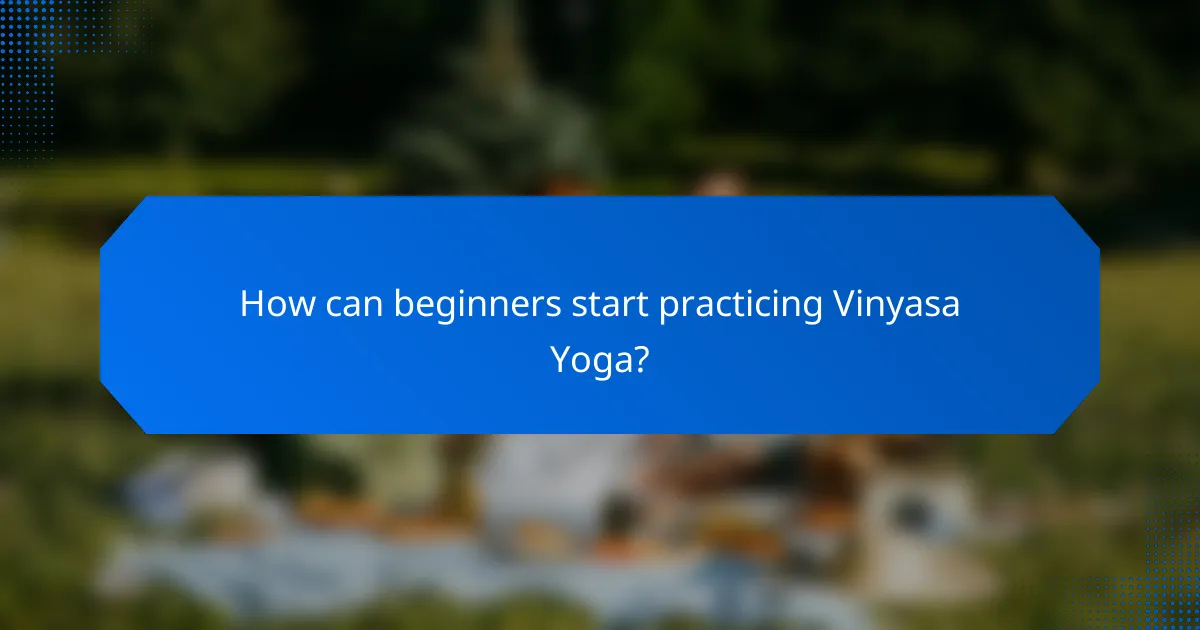
How can beginners start practicing Vinyasa Yoga?
Beginners can start practicing Vinyasa Yoga by finding accessible classes or online resources that cater to their skill level. It’s essential to focus on the flow of movements and breath, gradually building strength and flexibility.
Join local classes in London
Joining local classes in London is an excellent way for beginners to immerse themselves in Vinyasa Yoga. Look for studios that offer introductory courses or drop-in sessions specifically designed for newcomers.
Many studios provide a welcoming environment where instructors can offer personalized guidance. Check platforms like ClassPass or Mindbody to find classes that fit your schedule and budget, typically ranging from £10 to £20 per session.
Utilize online platforms like YogaGlo
Online platforms like YogaGlo offer a variety of Vinyasa Yoga classes suitable for beginners. These platforms provide flexibility, allowing you to practice at home at your own pace.
Subscriptions generally cost around $18 to $20 per month, giving you access to numerous classes led by experienced instructors. Look for beginner-specific courses that focus on foundational poses and techniques.
Follow beginner-friendly YouTube channels
YouTube is a treasure trove of beginner-friendly Vinyasa Yoga channels. Channels like Yoga with Adriene and Fightmaster Yoga offer free classes that guide you through basic flows and postures.
These videos often include modifications for different abilities, making it easy to adapt the practice to your needs. Aim for sessions that are 20 to 30 minutes long to start, gradually increasing as you gain confidence and strength.

What equipment is needed for Vinyasa Yoga?
To practice Vinyasa Yoga effectively, you’ll need a few essential pieces of equipment that enhance your experience and support your practice. The primary items include a yoga mat, blocks, and a strap, each serving a specific purpose to improve grip, alignment, and flexibility.
Yoga mat for grip and comfort
A good yoga mat is crucial for Vinyasa Yoga as it provides grip and cushioning during dynamic movements. Look for a mat that is at least 4 to 6 mm thick to ensure comfort while maintaining stability.
Consider materials like natural rubber or PVC for durability and traction. Mats with textured surfaces can help prevent slipping, especially during more vigorous flows.
Blocks for support and alignment
Yoga blocks are versatile tools that assist in achieving proper alignment and providing support in various poses. They can help you modify poses to suit your level, making them accessible for beginners while still beneficial for advanced practitioners.
When choosing blocks, opt for lightweight foam or cork materials. Keep two blocks handy for poses that require extra support, such as triangle or half-moon poses.
Strap for flexibility
A yoga strap is an excellent aid for enhancing flexibility and extending reach in poses. It allows you to hold stretches longer and achieve deeper positions without straining your muscles.
Look for a strap that is at least 6 to 8 feet long and made from durable cotton or nylon. Use it in poses like seated forward bends or when practicing binds to improve your range of motion safely.
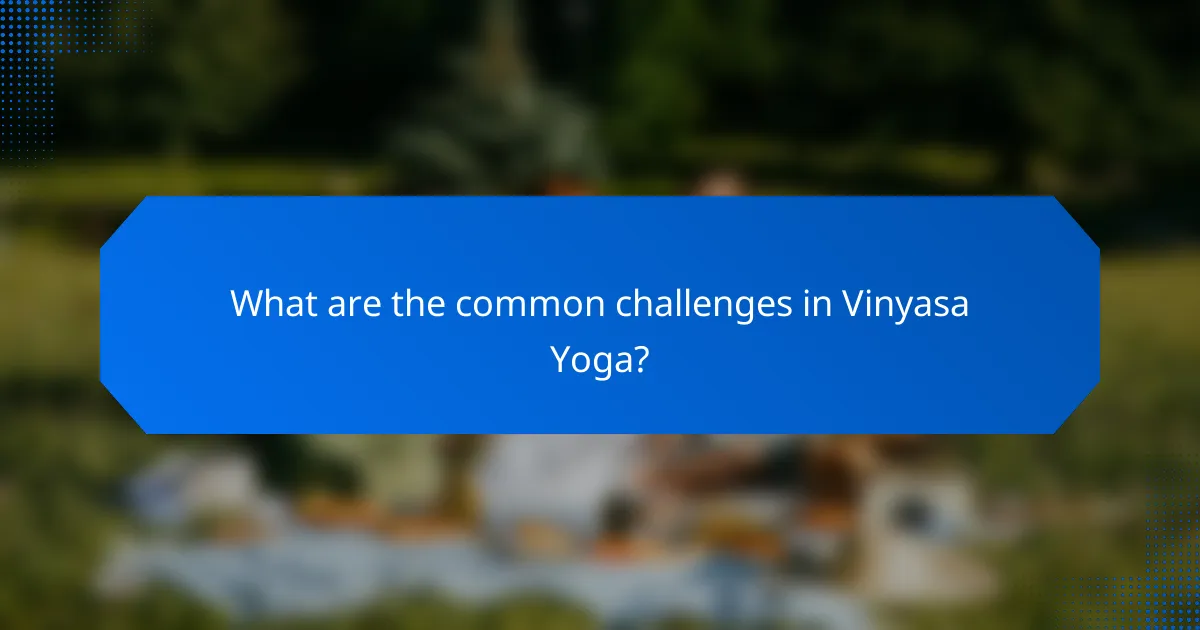
What are the common challenges in Vinyasa Yoga?
Vinyasa Yoga presents several challenges that practitioners may encounter, including breath control, alignment, and maintaining focus. Understanding these challenges can help individuals adapt their practice to enhance their experience and effectiveness.
Maintaining breath control
Breath control is essential in Vinyasa Yoga, as it synchronizes movement and helps maintain a steady flow. Practitioners often struggle to keep their breath deep and rhythmic, especially during more intense sequences. To improve breath control, focus on inhaling and exhaling fully, using techniques like Ujjayi breathing to create a calming effect.
A common pitfall is holding the breath during difficult poses. Instead, aim to establish a consistent breathing pattern that supports your movements, allowing for greater endurance and stability throughout the practice.
Achieving proper alignment
Proper alignment is crucial in Vinyasa Yoga to prevent injury and maximize the benefits of each pose. Many practitioners find it challenging to maintain correct alignment, particularly in dynamic flows where transitions occur quickly. Regularly checking in with your body and using mirrors or props can help ensure you are aligned correctly.
Consider taking the time to practice foundational poses at a slower pace to build muscle memory for alignment. Engaging a qualified instructor for feedback can also be beneficial, especially for beginners or those looking to refine their technique.
Staying focused during practice
Maintaining focus during Vinyasa Yoga can be difficult, particularly in a fast-paced environment. Distractions from the surroundings or wandering thoughts can disrupt the flow and diminish the practice’s effectiveness. To enhance concentration, establish a clear intention before starting your session and return to it whenever your mind begins to drift.
Incorporating mindfulness techniques, such as focusing on the sensations in your body or the rhythm of your breath, can help anchor your attention. Practicing in a quiet space or using calming music may also assist in creating a more focused atmosphere for your yoga practice.

How can Vinyasa Yoga be adapted for different levels?
Vinyasa Yoga can be easily adapted for practitioners of all levels, making it accessible and beneficial for everyone. By incorporating modifications and variations, beginners can build confidence while more advanced students can deepen their practice.
Modifications for beginners
Beginners in Vinyasa Yoga can benefit from several modifications to ensure a safe and enjoyable experience. Starting with basic poses and gradually introducing more complex sequences allows newcomers to build strength and flexibility at their own pace.
Common modifications include using props such as blocks, straps, or bolsters to assist in achieving proper alignment. For instance, a beginner may use a block under their hands in a forward fold to reduce strain and enhance stability.
Additionally, beginners should focus on slower transitions between poses, allowing time to understand each movement. Practicing with a knowledgeable instructor can provide personalized adjustments and support, ensuring a solid foundation for future progress.

